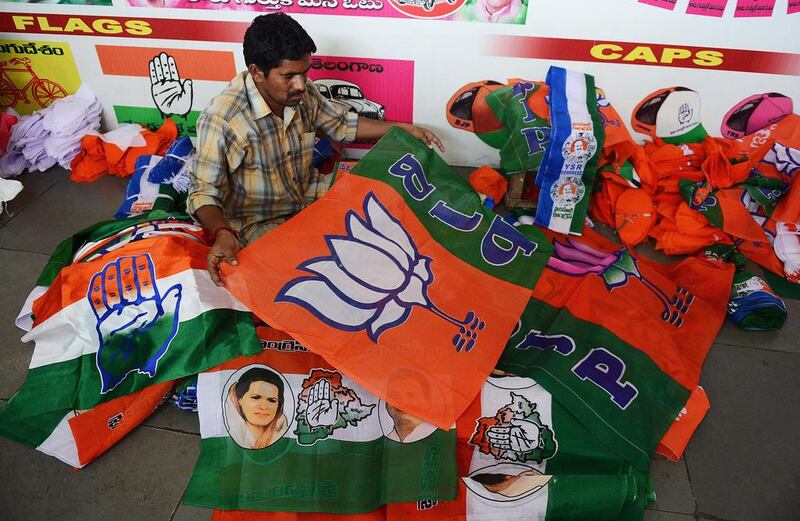NEW DELHI // Indian politicians are expected to spend around $5 billion (Dh18bn) on campaigning for elections next month – a sum second only to the most expensive US presidential campaign of all time – in a splurge that could give India’s floundering economy a temporary boost.
India’s campaign spend, which can include cash stuffed in envelopes as well as multi-million-dollar ad campaigns, has been estimated at $4.9bn by the Centre for Media Studies, which tracks spending.
That is triple the expenditure the centre said was spent on electioneering in the last national poll in 2009 – partly a reflection of a high-octane campaign by the pro-business opposition candidate for prime minister, Narendra Modi, who started nationwide rallies and advertising last year.
“They started much before, and they are also focusing on states where they are traditionally not strong. They are leaving no area untouched,” said N Bhaskara Rao, chairman of the Centre for Media Studies.
The campaign spending for this election could give a boost to the economy, which has been heading for its longest slump since the 1980s. Economists have forecast a second year of growth below 5 per cent in the financial year ending this month.
Candidate and party funding in India is opaque and the source of much of the spending is hard to ascertain, but the Centre for Media Studies and other transparency advocates say the main contenders have built up large war chests.
“This election spending largesse will help to boost Indian consumption expenditure over the second quarter of 2014, but this will be a temporary spike,” said Rajiv Biswas, the Asia-Pacific chief economist at IHS Global Insight.
India’s projected campaign spending is rivalled only by the $7bn spent by candidates, parties and support groups in the 2012 US presidential race, the world’s most expensive, according to data provided by the US election commission.
Spending on previous Indian elections have benefited a wide range of businesses, from media groups and advertisers that rake in campaign-ad revenues to consumer-based firms that capitalise indirectly on the overall jump in spending, such as motorbike manufacturers and brewers.
India’s advertising industry expects to see an $800 million injection during the election season, according to an outlook by the country’s largest local agency, Madison Media. That should benefit media firms, such as DB Corp, which owns the high-circulation Hindi language daily Dainik Bhaskar.
Much of India’s campaign spend will remain in its thriving black economy.
Rules allow candidates to spend $114,000 on campaigns for a parliament seat but the real cost of winning is about 10 times that, thanks to spending on rallies, fuel and media campaigns that often include payments for coverage.
Indian politicians regularly bribe voters with cash payouts or alcohol to secure their support. Recent state elections have seen innovations such as getting money to voters via mobile phone credit and envelopes of cash delivered in morning papers.
In the past three years, election authorities seized concealed cash of about $33m from politicians, some if it stashed in helicopters, milk lorries and even funeral vans, a former election commissioner said.
The dates for the month-long election starting on April 7 were announced last week, with polls staggered in nine stages to help security forces prevent polling booth fraud.
Despite evidence of vote-buying, India’s elections are now largely seen as free and fair on polling day.
However, chief election commissioner VS Sampath said last week he was worried about “money power” – heavy spending and the use of illegal funds to influence the outcome.
The Centre for Media Studies’ spending projections are based on analyses of rising costs in local and state elections in the past five years. It also surveys voters on prevalence of bribes.
Narendra Modi’s Bharatiya Janata Party (BJP) got off to an early start in campaigning, pushing into the south where it is weak and has avoided spending money in the past.
Mr Modi’s BJP-led coalition has a strong lead over the ruling Congress party in opinion polls, but it is unlikely to win an outright majority.
Some of Mr Modi’s fund-raising is led by a seven-member team, including Deepak Kanth, a former investment banker previously with Citibank in London. This team has organised an online fund-raising drive in India and is also targeting donations from wealthy Indians living in Hong Kong and Singapore.
This team has raised only $4m, a party source said, but shows how far Mr Modi is casting his net for campaign funds.
* Reuters





